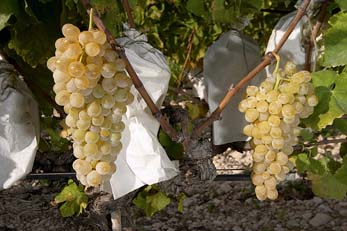Articles
01 January 2010
The grapes of Janus
Every January 1, the notes of the March Radetzky by J. Srauss fills us up with energy to carry out all our intentions of improvement and amendment, and to emphasize our desires of happiness for the year that begins.
Julio Cesar, the Roman emperor, reformed the calendar, moving the beginning of the year from March 25 to January 1, to receive Janus (1) with gifts and celebrations. The former Romans used to eat grapes and dates for that date (as Ovidius (2), the poet, describes) and, today, 20 centuries later, the grapes have a protagonist role in all the rituals for good auguries: a grape for each of last twelve rings of the year seals our votes and reaches the conjuration to attract the good luck.
This year almost two million kilos of Aledo have been commercialized. It is the pocketed table grape from the Vinalopó (3), the variety from Alicante with denomination of origin and late recolection.
In 1909, because of an excess of production the farmers of the area decided to give a bag with twelve grapes free for all those who usually came in the city center of Madrid to celebrate the end of the year, installing this way, the Spanish tradition.
Christmas and the excesses of the banquets are left behind now and January is a time for regeneration and for " tight belts" but we can go on eating grapes, more than twelve and also in a more quiet way. Their content in antioxidants, minerals, vitamins, sugars and fiber will help us to have a good and healthy year.
Happy 2010!
Dra. Laura Gosalbo
January 1, 2010
Notes:
(1) Janus, door in Latin, was the God of the beginning and the one with two faces: an old man with a rod in the hand was looking backward while, on the other side, a young man was directing his look ahead with a key in the hand.
(2) The roman poet Publius Ovidius Naso wrote Fastos a poetical calendar where he describes the roman feasts, month by month.
(3) Regulatory Council of the grape from the Vinalopó.
http: // uva-vinalopo.org/wp/

Vinalopó grapes
> BackJulio Cesar, the Roman emperor, reformed the calendar, moving the beginning of the year from March 25 to January 1, to receive Janus (1) with gifts and celebrations. The former Romans used to eat grapes and dates for that date (as Ovidius (2), the poet, describes) and, today, 20 centuries later, the grapes have a protagonist role in all the rituals for good auguries: a grape for each of last twelve rings of the year seals our votes and reaches the conjuration to attract the good luck.
This year almost two million kilos of Aledo have been commercialized. It is the pocketed table grape from the Vinalopó (3), the variety from Alicante with denomination of origin and late recolection.
In 1909, because of an excess of production the farmers of the area decided to give a bag with twelve grapes free for all those who usually came in the city center of Madrid to celebrate the end of the year, installing this way, the Spanish tradition.
Christmas and the excesses of the banquets are left behind now and January is a time for regeneration and for " tight belts" but we can go on eating grapes, more than twelve and also in a more quiet way. Their content in antioxidants, minerals, vitamins, sugars and fiber will help us to have a good and healthy year.
Happy 2010!
Dra. Laura Gosalbo
January 1, 2010
Notes:
(1) Janus, door in Latin, was the God of the beginning and the one with two faces: an old man with a rod in the hand was looking backward while, on the other side, a young man was directing his look ahead with a key in the hand.
(2) The roman poet Publius Ovidius Naso wrote Fastos a poetical calendar where he describes the roman feasts, month by month.
(3) Regulatory Council of the grape from the Vinalopó.
http: // uva-vinalopo.org/wp/

Vinalopó grapes





